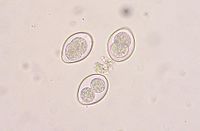Coccidia facts for kids
Quick facts for kids Coccidia |
|
|---|---|
 |
|
| Coccidia oocysts | |
| Scientific classification | |
| Domain: | |
| Kingdom: | |
| Superphylum: | |
| Phylum: | |
| Class: | |
| Subclass: |
Coccidia
|
Coccidia are tiny, single-celled living things that you can only see with a microscope. They are a type of parasite, which means they live inside another living thing, called a host, and get their food from it. Coccidia are special because they are obligate parasites, meaning they must live inside a host to survive.
These tiny parasites usually live in the intestines of many different animals. They are a big group of parasites known as Apicomplexa, and they can cause sickness in their animal hosts.
Contents
What are Coccidia?
Coccidia are part of a group called protozoa, which are very simple, single-celled organisms. Think of them as tiny, invisible creatures that can cause trouble for animals. They are known for forming spores, which are like tiny protective shells that help them survive outside a host for a long time.
These parasites are found all over the world. They can infect many kinds of animals, including pets like dogs and cats, farm animals like chickens and cows, and even wild animals.
How Animals Get Coccidia
Animals usually get Coccidia by swallowing something that has the parasite's eggs, called oocysts. These oocysts are passed out in the poop of an infected animal.
- If an animal eats contaminated food or drinks contaminated water, they can pick up the oocysts.
- Young animals are often more likely to get Coccidia. This is because their immune systems are still developing.
- Stress, crowded living conditions, or poor hygiene can also make it easier for the infection to spread.
Once swallowed, the oocysts open up in the animal's gut. The tiny parasites then start to multiply inside the cells of the intestine.
What Happens When an Animal Has Coccidia?
When Coccidia multiply in an animal's intestines, they can damage the gut lining. This damage can lead to various health problems.
Common Symptoms
The most common sign of Coccidia infection is diarrhea. This can range from mild to severe.
- The diarrhea might be watery or contain mucus.
- Sometimes, there might be blood in the stool.
- Infected animals might also lose their appetite.
- They can lose weight and become weak.
- Young animals might not grow as well as they should.
In some cases, especially in very young or weak animals, the infection can be serious. It can lead to dehydration and even be life-threatening if not treated.
How Vets Help
If an animal shows signs of Coccidia, a veterinarian can help. They will usually take a sample of the animal's poop.
Diagnosis
- The vet looks at the poop sample under a microscope.
- They search for the tiny Coccidia oocysts.
- Finding these oocysts helps the vet confirm that Coccidia is the cause of the animal's sickness.
Treatment
- Coccidia infections are treated with special medicines. These medicines help to stop the parasites from multiplying.
- The vet will give instructions on how to give the medicine. It's important to follow these instructions carefully.
- Sometimes, other treatments are needed to help with symptoms like dehydration.
Prevention
Preventing Coccidia is important, especially in places where many animals live together.
- Keeping living areas clean is key. This means regularly cleaning up poop.
- Good hygiene helps stop the spread of oocysts.
- Making sure animals have clean food and water also helps.
- Reducing stress for animals can also make them less likely to get sick.
By understanding Coccidia and how it spreads, we can help keep animals healthy and happy.
See also
 In Spanish: Coccidiasina para niños
In Spanish: Coccidiasina para niños

